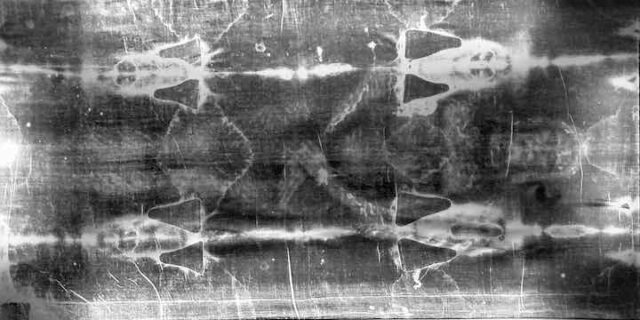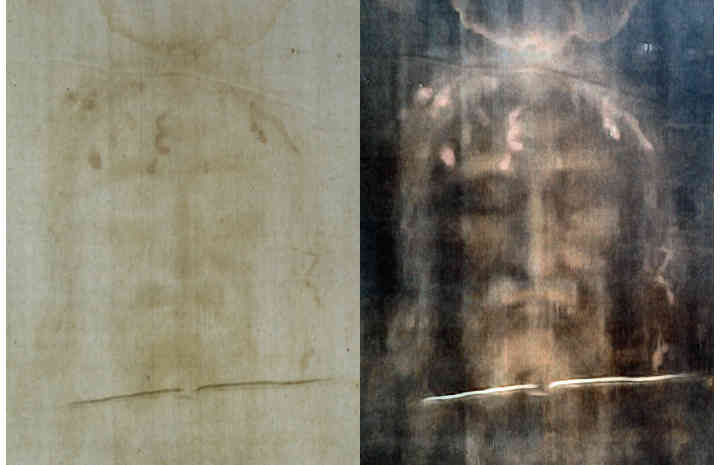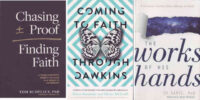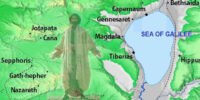The Turin shroud is a famous religious relic which is claimed to have been Jesus’ burial cloth, and contains an image of him. Sceptics say it is a medieval fake.
After decades of studies, are we any closer to a definitive answer on whether it could be genuine, or not?
A brief history of the shroud
The Bible records that Jesus was crucified about 30 CE and buried in a rock cut tomb. In accordance with Jewish burial customs, he was reportedly anointed with spices and wrapped in a large linen cloth and at least one, and probably several smaller cloths.
A day and two nights later, several women went to the tomb to complete the anointing, only to find the body gone but the grave clothes remaining. His followers began to proclaim that he had been resurrected.
More than a millennium later, in 1355 CE, a church in France began to exhibit a long linen cloth on which was the faint image of the front and back of a man, said to be the crucified Jesus. The Catholic church initially considered this burial shroud to be a work of art, but later it was seen as a genuine relic. It was thought that the knight who endowed the church had brought the shroud back from the Middle East.
In 1578, the shroud was moved to the cathedral in Turin in Italy, where it has remained ever since.
There had been earlier references to a linen cloth that may have been the same shroud, but these are uncertain. So the supposed history of the shroud from 30 CE to 1355 CE is unknown.
What the shroud looks like
The shroud is a piece of linen cloth about 4.4m x 1.4m. (Linen is a material made from flax.) The images on the shroud are supposedly those that would be obtained if Jesus’ body was placed on his back on the shroud with a large section wrapped over his head and laid down to cover the front of his body.
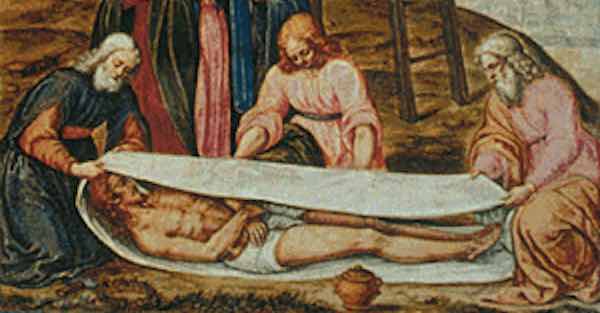
It is claimed that the shroud shows details consistent with Jesus crucifixion, such as blood, nail marks, a spear injury in the side, a crown of thorns on the head, etc. However some of these details are not easy to see. Negatives of photos taken of the shroud show the image a little more clearly.
The debate
In the last 50 years, numerous studies have been done to try to determine the authenticity or otherwise of the shroud – radiocarbon and other dating methods, analysis of pollen on the cloth, close examiniation of the image, analysis of the blood or pigment, etc.
- Various hypotheses have been suggested to explain the image, but none has stood up to examination. Some say the image has been painted on, but most say the origin of the image is unknown.
- Some say the image accurately depicts a crucified man, and shows details that medieval artist couldn’t have known or even seen, but others say it is out of proportion and couldn’t come from a real person.
- Some say the blood patterns are realistic, and analysis shows traces of chemicals found in trauma victims, but others say the blood patterns couldn’t have occurred with a body being wrapped for burial. Some have argued that the “blood” is actually the remains of paint, but this view seems to have lost favour this century.
- Radiocarbon testing indicates a medieval date for the cloth, which would prove the shroud wasn’t used to bury Jesus. But some say the testing was flawed, and point to other physical and chemical testing that indicate a first century date (or thereabouts).
And so the arguments continue between believers and sceptics. For a summary of the evidence and arguments, see Does the Turin Shroud really show an image of Jesus?
Six questions
In the end, I feel what matters is the answers to six questions.
1. How old is the shroud?
There is good evidence for both an ancient and a medieval date for the fabric, with carbon dating showing a medieval date. We have to give most credence to the radiocarbon results as the method is well understood. Until a new set of radiocarbon dates are obtained, we have to simply say that any date in or near the first millennium CE is possible, but a later date more likely. In view of the uncertainties, new radiocarbon testing is the single most important information to assist in resolving the shroud’s genuineness.
However even if the date is ancient, that doesn’t necessarily mean the image is ancient.
2. Where does then material come from?
From analysis of the linen and pollen, it seems most likely the cloth was created in the Middle East. But this doesn’t necessarily mean the image was also created in the Middle East.
3. Is the image formed by a crucified man?
There are many details, some of which wouldn’t have been known to a medieval artist, which suggest the image is of a crucified man. However there are also details that suggest the bloodstains and the image were created by an artist, not by the wounds and body of a crucified man. This evidence seems to slightly favour authenticity.
4. Is the man Jesus?
It is possible that the image is of someone else, but there are enough unusual details to suggest it was more likely either an image created by Jesus’ body, or intended to look that way.
However the lack of any mention of the shroud until centuries after Jesus’ death, and no provenance for the shroud until a millennium afterwards make it difficult to assign it to Jesus.
5. How was the image produced?
Whether produced by a corpse, a resurrection, or an artist, no-one can explain how the image was formed, or reproduce it. It doesn’t seem to have been painted in any way. If this mystery could be solved, the genuineness or otherwise of the shroud could likely be determined, but while the mystery remains we cannot rule out something highly unusual happening.
6. Is it a fake?
There is a lot of evidence – more in favour of authenticity than against – which makes it easy for some to accept the shroud was indeed used in Jesus’ burial.
But for the shroud to be genuinely from Jesus’ burial, its age, the location of its origin, the realism of the image and bloodstains would all have to be favourable. If any one of these factors indicates otherwise, it seems we’d have to reject the possibility. So the odds are against it being genuine.
Until new radiocarbon dating confirms an ancient date for the shroud, I can’t believe it is genuine. And until the sceptics can show how the image was produced, I can’t feel confident that something strange hasn’t happened to confound the sceptical case.
So at this stage I’m somewhat sceptical. But like many others, I wish new radiocarbon dating could be carried out to possibly settle the matter once and for all.
Check out the evidence and the arguments, with many references, at Does the Turin Shroud really show an image of Jesus?
Top photo: Negative of the “front” side of the Turin shroud. Unknown author, photographed at Saint-Sulpice, Paris, Wikipedia.
Graphic of wrapping Jesus body taken from the Descent from the Cross, by painter Giulio Clovio, c. 1540, in Wikipedia.
